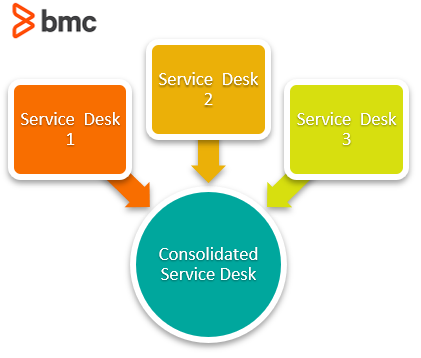The global pandemic has brought a significant burden to IT teams who were already under strain from existing challenges, often as a result of digital transformation. An April 2020 survey by Gartner of 229 HR leaders revealed that nearly 50% of organizations reported 81% or more of their employees are working remotely this year.
Dealing with an avalanche of remote devices, connections, and staff has strained even the best of service desks. And one of the strategies being deployed to ensure the service desk continues to support business strategy in the digital age is service desk consolidation.
What is service desk consolidation?
ITIL® 4 defines the service desk as the entry point and single point of contact for the service provider for all users, where your company can capture the demand for service requests and incident resolution. Diversity in the service desk is a function of different approaches and capabilities to serve different needs.
Many organizations have seen it fit to have more than one functional service desks to deal with different contexts based on geography, service portfolios, and skillsets. For instance:
- An HR SaaS company might deploy different service desks for different regions where the labor laws and human capital requirements needs to be contextualized through the service desk.
- Another organization might see the need to have different service desks serving different needs, e.g. internal versus external services.
- Still another might see the need to separate service desks based on different skills, e.g. specialized higher-level support dealing with payment issues, another for logistics etc.
This approach can have many benefits, like personalization and specialization. But there are drawbacks to this approach, too.
Drawbacks of multiple service desks
Organizations that support multiple service desks might experience certain drawbacks:
- Cost. Maintaining multiple service desk staff using diverse technologies and different locations invariably hits the expense column in a significant way.
- Resource intensiveness. Multiple service desks are resource intensive and require significant investment in knowledge and technology to keep them operational.
- Handoff challenges. Where handover of work from one desk to another is required, there might be challenges as a result of communication, knowledge, and context differences brought about by silos across different service desks.
As a result, some organizations have seen it fit to consolidate their multiple service desks into one.

Why consolidate service desks?
Gartner defines the consolidated service desk (CSD) as the hub where you:
- Consolidate the needs of support groups, distributors, suppliers, and customers
- Integrate network and system management tools
According to EMA, there is significant drive to unify IT across its many silos, promoting and measuring IT operational efficiencies, and consolidating insights critical for IT-to-business planning supportive of both IT and digital transformation. The main drivers for decided to consolidated include:
- Efficiency. Consolidating service desks reduces system license fees and simplifies management of staff and activities by sharing resources.
- Effectiveness. Consolidation leads to better utilizing service desk staff and reducing process and data inconsistency. There’s potential even for overall higher skill levels as more service desk agents are more familiar with more topics, thanks to a greater variety of events and knowledge sharing. Management also has better visibility on areas for improvement and innovation at the consolidated service desk.
- Customer experience. Reduced handoff of users across service desks leads to better experience. Consolidation reduces delays by bringing together the diverse skillsets to address any issue type.
Consolidation strategies
How does an organization plan for consolidation? InfoTech Research Group suggests that every step should put people first. This is because, despite the allure to focus the strategy on designing processes and technologies for the target architecture, the common obstacle to success is workforce resistance to change.
A well-structured organizational change program can go a long way to ensuring success in service desk consolidation. Referencing John Kotter’s 8 steps for leading change, the following activities are critical to successful service desk consolidation:
- Create a sense of urgency. Make all stakeholders aware of the urgent need for consolidation by providing clear information on why having multiple service desks is an increasing detriment to the organization’s goals and customer satisfaction.
- Build a guiding coalition. Get representatives from the different service desks and business stakeholders who are passionate on the value proposition that consolidation will deliver.
- Form a strategic vision and initiatives. Define the future picture, post-consolidation, and the activities required to deliver it, including assessing your current state, selecting resources to retain/acquire, defining, designing, and implementing processes, technologies, and knowledge for the consolidated state.
- Enlist a volunteer army. Provide training and awareness to get buy in from staff who will support the consolidated service desk.
- Remove barriers, enable action. Any existing hierarchies or processes that interfere with the consolidation effort should be rooted out quickly and comprehensively.
- Generate short-term wins. Recognize, communicate, and celebrate any successes from the consolidated service desk, such as improved performance and customer satisfaction, in order to energize volunteer support.
- Sustain acceleration. Commit to completion of the consolidation effort even if challenges and setbacks arise.
- Institute change. Define structures and controls such as policies and training to ensure consolidation is the default state.
It is evident that implementing a consolidated service desk is no easy task. Defining and implementing common processes, tools, data elements and reporting, while eliminating redundancies and considering context issues such as language and culture is a significant challenge that requires leadership commitment and support by all parties.
The value to be gained from the consolidated service desk must be well understood and sought by all means necessary if success is to be achieved.







